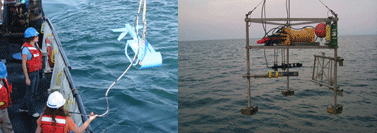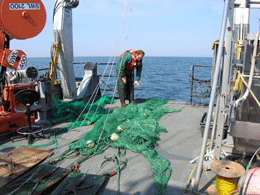Dead Zones
Air Date: Week of October 7, 2005

(Courtesy of NOAA-GLERL)
Dead zones--large areas of water with little oxygen--occur when excess fertilizer and untreated sewage seep into the waters. The dead zones are usually seasonal and they cause fish and other bottom-dwelling animals to move outside the area to avoid being suffocated. Much underwater life also dies. Since the 1960s the number of dead zones worldwide has doubled with each passing decade. In Lake Erie, a massive multiyear study is underway to study how the lake’s ecosystem is affected by its dead zone. Producer Mhari Saito has our report.
Transcript
CURWOOD: Nearly every summer, the bottom waters of Lake Erie’s central and western basins lose so much oxygen that fish can’t survive. While Lake Erie’s so-called “dead zone” is expected to disappear this year as the weather cools, around the world low oxygen waters are a growing problem, killing fish and changing local ecosystems. This year government scientists from the U.S. and Canada have launched one of the largest probes ever of Lake Erie’s dead zone. Mhari Saito reports.
[SOUNDS OF HAULING FISH, BOATS, RIVER]
SAITO: Joe Herr and his crew haul crates of iced yellow perch from the deck of his boat and onto the back of his son’s SUV. Lake Erie has been the source of his family’s livelihood for decades. This grey-bearded fisherman has had to find ways to catch fish in Lake Erie through good times and bad.
HERR: When I started fishing in it, it looked like coffee with cream in it. Back in the 50s and 60s it was really bad, but now it’s blue, clear.
SAITO: Almost too clear. On this Indian summer day, the lower layer of Lake Erie’s central basin is hypoxic. That means the bottom few meters of water in much of the lake have extremely low levels of oxygen.
HERR: It’s strictly when the weather gets hot, the water gets trapped down below. It stays ice cold, loses its oxygen. Fish just swim away from it.
SAITO: Lake Erie’s dead zone has been around for decades. But accumulations of agricultural runoff and excess sewage made the Lake’s hypoxia so dramatic, in the 1970s the U.S. and Canada signed agreements to try to end it. Reductions of phosphates in laundry detergents and municipal water treatment plants have cut the amount of phosphorous going into Lake Erie by more than half. The dead zone seemed to improve. But recently scientists have found disturbing signs.

The oxygen levels of Lake Erie during the dead zone season. (Courtesy of NOAA-GLERL)
MATISOFF: In the western part of the lake we have these toxic and harmful algal blooms occurring more frequently, much like they did in the 60s and 70s.
SAITO: Gerald Matisoff heads Case Western Reserve University’s Geology Department.
MATISOFF: In the central basin we have low oxygen,much like we had in 60s and 70s, and then in the eastern part in the last few years – though not this year - we’ve had significant outbreaks of avian botulism. Now, what we don’t know is whether or not these are all related or they’re all independent and the result of simultaneous events that happen to be dominant in certain parts of the lake at the same time.
[BOAT ENGINE/DECK NOISE]
SAITO: Fifteen miles north of Cleveland, government scientists look for clues in Lake Erie’s waters. They hoist a small metal crane onto the deck of their boat. The crane drops a couple of handfuls of mud from the lake bottom into a gray plastic tub. Two scientists dig through it, looking for life.
LUDSIN: Do you see anything?
SCOTT: arnomids…little red larvae…
LUDSIN: So, the oxygen, Scott, was a half milligramper liter…
SAITO: Oxygen saturation of a half milligram per liter of water is very low. Most fish can’t survive at anything below two milligrams. Stuart Ludsin is an ecologist with the Great Lakes Environmental Research Laboratory.
LUDSIN: Part of what we’re looking at is how does insect larvae vary in areas of high and low oxygen. The expectation would be that in severe hypoxic events these organisms would die and be unavailable for food.
[DAY DECK SOUNDS, HYDRAULICS]
SAITO: Ludsin believes studying the lake’s food web may reveal clues. Researchers started to find low oxygen spots in Lake Erie in late June. Ludsin says the dead zone forced fish off the bottom, home to most of their prey.
LUDSIN: They now are cut off from access to their necessary food and might be forced to live up in the water column and feed on sub-optimal prey like zooplankton. And that, in turn, might lead to reduced growth. So those are the kinds of things we are going to try and get at.

(Courtesy of NOAA-GLERL)
SAITO: Ludsin and his team use sonar and underwater sensors to analyze the lake’s waters – but the best way to find out what’s avoiding Lake Erie’s low oxygen depths is to cast a fishing net and see what comes up.
LOUDSPEAKER: We’re good to fish. Okay!
[TRAWL BOAT SOUNDS]
SAITO: After 10 minutes of trawling a large net, the scientists pull in their catch. They shake the flopping fish into a plastic bucket.
[DECK SOUNDS]
SCIENTISTS: Ooooh! Four, gross underestimate!

Scientists trawl a large net to see what lives in Lake Erie. (Courtesy of NOAA-GLERL)
LUDSIN: White perch, yellow perch….three perch, four perch.
[FISH FLIPPING]
LUDSIN: Oh, a little goby…
[BOAT NOISES FADE OUT]
SAITO: The goby fish and zebra mussel are among 170 types of invasive species in the Great Lakes. Shipping vessels are blamed for bringing transplants into these waters at a rate of more than one per year. Scientists are eager to understand how these new residents are impacting Lake Erie’s dead zone. But answers to the lake’s quandaries could mean new challenges.Researchersadmit stopping the influx of invasive species and finding new places to cut pollution flow into Lake Erie would be difficult.
[DOCK SOUNDS]
SAITO: Back at the dock, Joe Herr and his crew laugh when they hear people worrying about Lake Erie’s dead zone. Lake Erie’s fisheries are more productive than all the other Great Lakes combined and Herr has lasted nearly 50 years on Lake Erie because he has adapted to its changes. These days, he uses a depth finder to look for Lake Erie’s dead zone, and plans accordingly.
HERR: We know where it should be so we go set our nets ahead of time and wait for it and herd the fish to us.
SAITO: While the dead zone may help an old fisherman learn new tricks, Herr is carefully watching to make sure Lake Erie’s ongoing changes don’t negatively impact his daily catch. For Living on Earth, I’m Mhari Saito at the southeastern edge of Lake Erie.
Links
Great Lakes Environmental Research Lab
"Dead Zones Spreading in World Oceans" BioScience, July 2005
Living on Earth wants to hear from you!
Living on Earth
62 Calef Highway, Suite 212
Lee, NH 03861
Telephone: 617-287-4121
E-mail: comments@loe.org
Newsletter [Click here]
Donate to Living on Earth!
Living on Earth is an independent media program and relies entirely on contributions from listeners and institutions supporting public service. Please donate now to preserve an independent environmental voice.
NewsletterLiving on Earth offers a weekly delivery of the show's rundown to your mailbox. Sign up for our newsletter today!
 Sailors For The Sea: Be the change you want to sea.
Sailors For The Sea: Be the change you want to sea.
 The Grantham Foundation for the Protection of the Environment: Committed to protecting and improving the health of the global environment.
The Grantham Foundation for the Protection of the Environment: Committed to protecting and improving the health of the global environment.
 Contribute to Living on Earth and receive, as our gift to you, an archival print of one of Mark Seth Lender's extraordinary wildlife photographs. Follow the link to see Mark's current collection of photographs.
Contribute to Living on Earth and receive, as our gift to you, an archival print of one of Mark Seth Lender's extraordinary wildlife photographs. Follow the link to see Mark's current collection of photographs.
 Buy a signed copy of Mark Seth Lender's book Smeagull the Seagull & support Living on Earth
Buy a signed copy of Mark Seth Lender's book Smeagull the Seagull & support Living on Earth

